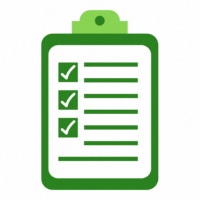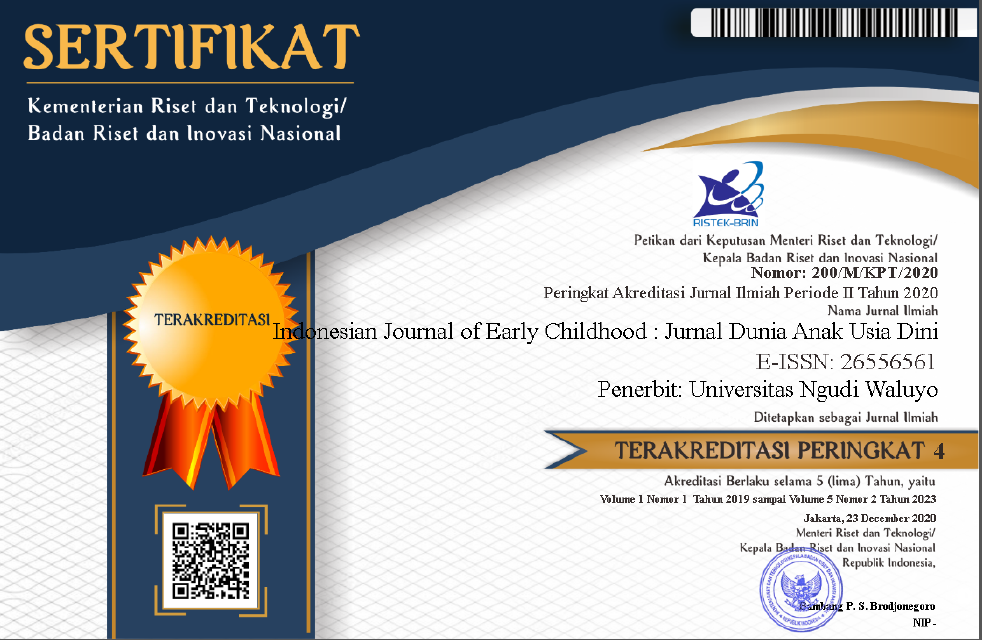Meningkatkan Kemampuan Motorik Halus Anak Melalui Kegiatan Kolase Pada Kelompok A Di TK Wulele Sanggula II
Improving Children's Fine Motor Skills Through Collage Activities in Group A at Wulele Sanggula II Kindergarten
DOI:
https://doi.org/10.35473/ijec.v7i1.3343Abstract
Motor development is the process by which children acquire the skills and movement patterns necessary to perform various physical activities. Early childhood education (PAUD) also plays an important role in detecting and providing early intervention for various developmental problems that may occur in children. This research focuses on describing children's fine motor skills through collage activities, which are designed to improve both aspects simultaneously. The research techniques used are observation and documentation. Observation allows researchers to see phenomena directly, while documentation provides additional data that can be analyzed further. The results of the research can be proven to be an effective method for improving children's fine motor skills and encouraging their creativity. This activity involves hand-eye coordination as well as various fine motor skills, such as arranging and gluing, which supports children's fine motor development.
ABSTRAK
Perkembangan motorik adalah proses di mana anak-anak memperoleh keterampilan dan pola gerakan yang diperlukan untuk melakukan berbagai aktivitas fisik. Pendidikan anak usia dini (PAUD) juga berperan penting dalam mendeteksi dan mengintervensi dini berbagai masalah perkembangan yang mungkin terjadi pada anak. Penelitian ini berfokus pada mendeskripsikan kemampuam motorik halus anak melalui kegiatan kolase, yang di rancang untuk meningkatkan kedua aspek tersebut secara bersamaan. Adapun teknik penelitian yang di gunakan adalah observasi dan dokumentasi, Observasi memungkinkan peneliti melihat fenomena secara langsung, sementara Dokumentasi memberikan data tambahan yang bisa dianalisis lebih lanjut. Hasil penelitian yang di dapat terbukti bahwa metode yang efektif untuk meningkatkan kemampuan motorik halus anak dan mendorong kreativitas mereka. Aktivitas ini melibatkan koordinasi mata dan tangan serta berbagai keterampilan motorik halus, seperti menyusun dan menempel, yang mendukung perkembangan motorik halus anak.
References
Arikunto, Suharsimi.(2014). Penelitian Tindakan Kelas. Jakarta: PT Bumi Aksara.
Asmara, B. (2020). Meningkatkan kemampuan motorik halus melalui kegiatan menggunting pada anak usia dini di kelompok A tk khadijah surabaya. Pedagogi: Jurnal Anak Usia Dini Dan Pendidikan Anak Usia Dini, 6(1), 11-23.
Fatmawati, F. A. (2020). Pengembangan fisik motorik anak usia dini. Caremedia Communication.
Latief, S. (2020). Pendidikan Anak Usia Dini (Paud) Sebagai Pondasi Pembentukan Karakter Dalam Era Revolusi 4.0 Dan Society 5.0: Teknik Dan Keberlanjutan Pendidikan Karakter. Jurnal Literasiologi, 3(2).
Sulaiman, U., Ardianti, N., & Selviana, S. (2019). Tingkat pencapaian pada aspek perkembangan anak usia dini 5-6 tahun berdasarkan strandar nasional pendidikan anak usia dini. NANAEKE: Indonesian Journal of Early Childhood Education, 2(1), 52-65.
WINARTI, P. (2019). MENUMBUHKAN KREATIVITAS ANAK MELALUI KEGIATAN KOLASE DENGAN KERTAS LIPAT PADA KELOMPOK B TK DANA WARGA KECAMATAN SIMOKERTO SURABAYA (Doctoral dissertation, Universitas Muhammadiyah Surabaya).
Yuliani, W., & Supriatna, E. (2023). Metode Penelitian Bagi Pemula. Penerbit Widina.
Downloads
Published
How to Cite
Issue
Section
License
Copyright (c) 2025 Indonesian Journal of Early Childhood: Jurnal Dunia Anak Usia Dini

This work is licensed under a Creative Commons Attribution-ShareAlike 4.0 International License.
Please find the rights and licenses in Indonesian Journal Of Early Childhood: Jurnal Dunia Anak Usia DIni. By submitting the article/manuscript of the article, the author(s) agree with this policy. No specific document sign-off is required.
1. License
The non-commercial use of the article will be governed by the Creative Commons Attribution license as currently displayed on Creative Commons Attribution-ShareAlike 4.0 International License.
2. Author(s)' Warranties
The author warrants that the article is original, written by stated author(s), has not been published before, contains no unlawful statements, does not infringe the rights of others, is subject to copyright that is vested exclusively in the author and free of any third party rights, and that any necessary written permissions to quote from other sources have been obtained by the author(s).
3. User Rights
Indonesian Journal Of Early Childhood: Jurnal Dunia Anak Usia Dini's spirit is to disseminate articles published are as free as possible. Under the Creative Commons license, Indonesian Journal Of Early Childhood: Jurnal Dunia Anak Usia Dini permits users to copy, distribute, display, and perform the work for non-commercial purposes only. Users will also need to attribute authors and Indonesian Journal Of Early Childhood: Jurnal Dunia Anak Usia Dini on distributing works in the journal and other media of publications.
4. Co-Authorship
If the article was jointly prepared by more than one author, any authors submitting the manuscript warrants that he/she has been authorized by all co-authors to be agreed on this copyright and license notice (agreement) on their behalf, and agrees to inform his/her co-authors of the terms of this policy. Indonesian Journal Of Early Childhood: Jurnal Dunia Anak Usia Dini will not be held liable for anything that may arise due to the author(s) internal dispute. Indonesian Journal Of Early Childhood: Jurnal Dunia Anak Usia Dini will only communicate with the corresponding author.
5. Miscellaneous
Indonesian Journal Of Early Childhood: Jurnal Dunia Anak Usia Dini will publish the article (or have it published) in the journal if the article’s editorial process is successfully completed. Indonesian Journal Of Early Childhood: Jurnal Dunia Anak Usia Dini's editors may modify the article to a style of punctuation, spelling, capitalization, referencing and usage that deems appropriate. The author acknowledges that the article may be published so that it will be publicly accessible and such access will be free of charge for the readers as mentioned in point 3.
Â
Every accepted manuscript should be accompanied by "Copyright Transfer Agreement" prior to the article publication.



